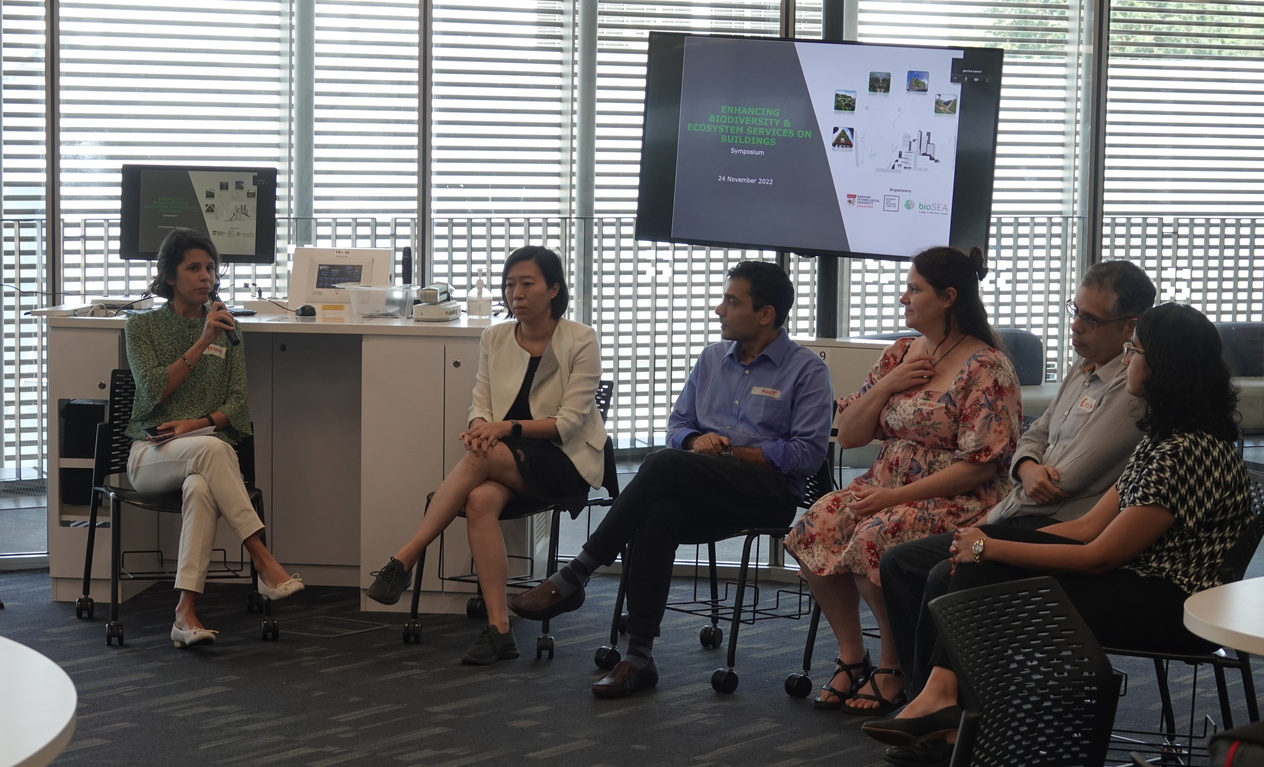Enhancing Biodiversity & Ecosystem Services - Symposium Reflections
bioSEA and Nanyang Technological University (NTU)’s Resilient and Inclusive Cities Lab co-organized a 1-day symposium on 24 November 2022 at NTU, Singapore. Titled Enhancing Biodiversity & Ecosystem Services on Buildings symposium, it brought together a group of 30 experts (speakers and participants) for an in-person session and many more who joined online from Singapore and internationally representing industry, government, and academia.

The rationale behind the symposium was to discuss ways to enhance biodiversity in buildings, quantify the benefits provisioned by ecosystem services and translate them into effective architectural & landscape design interventions for the built world.
As decarbonization and low-energy initiatives dominate the urban sustainability discourse, an important variable that could bolster sustainability efforts is the quantification and optimization of ecosystem services – the services provided by the environment that benefit humans.
Such services are not only provided by green spaces but also by green infrastructure on buildings, especially in dense cities like Singapore that promote green vertical urbanism. Strategically designed green infrastructure can benefit biodiversity and provide ecosystem service benefits when optimized can be a double win for sustainability.
The symposium comprised three parts – a morning session focused on design and assessment approaches, an afternoon session focused on research advances and frameworks, and a focused group discussion session that allowed more in-depth discussions and cross-pollination of ideas.

Morning Session
The symposium was opened by Mr. Wong Mun Summ, the Founding Director of WOHA Architects, who elegantly described WOHA’s philosophy of bringing nature to the built environment through their flagship projects such as OASIA Hotel Downtown, Park Royal @ Pickering, and Kampung Admiralty. Mun Summ recounted an incident from years ago when someone at a conference in the USA called WOHA as the architects who put trees on buildings. Mun Summ knew they were doing more. Years later, we know such scepticism is history. Building integrated vegetation has really kicked off globally.
Maibritt Zari, Associate Professor at the Auckland University of Technology in New Zealand, delivered a keynote lecture explaining her work on sustainable architecture and urban design through mimicking ecosystems.
Mayura Patil from the National Parks Board (NParks) explained NParks’ efforts towards Skyrise Greening and developing the LEAF landscape excellence assessment framework. Audrey Xu from the Housing Development Board (HDB) explained the HDB’s biophilic town framework.
Anuj Jain from bioSEA shared results and lessons learned from bioSEA’s biodiversity and ecosystem service assessments across key projects in Singapore. He shared the example from Kampung Admiralty development where the rooftop garden, which doubles up as a community farm, had the highest biodiversity among habitats in the neighbourhood. One of the contributors to this was the lack of pesticide use.
Finally, Erik Velasco, Associate Research Scientist from Molina Center for Strategic Studies in Energy and the Environment, shared his experience in assessing urban carbon sequestration in tropical Mexico and Singapore. His results suggest that urban ecosystems can sometimes switch between operating as a carbon sink or source depending on the management of the horticultural waste at the site. Incorporating horticultural waste is a crucial consideration in carbon sequestration estimates.
The morning session ended with a panel discussion comprising of the speakers and moderated by Perrine Hamel.

Afternoon session
Katharina Hecht from Utrecht University Netherlands (and bioSEA Associate) delivered the afternoon keynote address outlining her Kumu map-based tools that help visualize various building-integrated green design approaches and ecosystem services offered by projects and case studies globally.
Leanne Haan, also from Utrecht University Netherlands (and bioSEA intern), described the findings from vertical green wall assessments conducted during her recent internship in Singapore.
Terrence Chun Liang Tan delivered a short presentation about his work on urban climate mapping of greenery in Singapore.
Finally, Ash Welch ended the afternoon session with a futuristic note explaining how biodiversity net gain tools have worked in the UK and how they might fare in Singapore.
The afternoon session ended with a panel discussion comprising of the speakers and moderated by Anuj Jain.
Focused group discussion session
The participants were divided into five groups – Biodiversity, Air temperature regulation, Socio-cultural services, Storm Water Management, and Urban Carbon Sequestration. Each group had an hour of discussion. During this time, they collectively answered a number of questions on rating the importance, determining the most important motivations to measure, frameworks, opportunities, and challenges to integrate their topic in the built environment.

Next Steps
We are working towards a peer-reviewed publication to assimilate the best practices of nature-sensitive building design. It will include lessons learned during the symposium and beyond. Stay tuned for updates!
